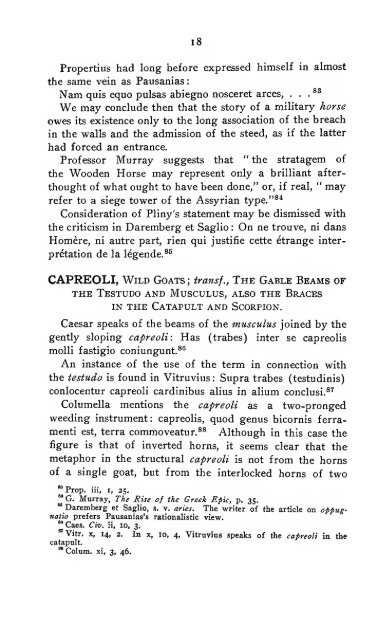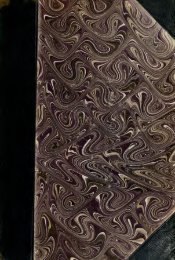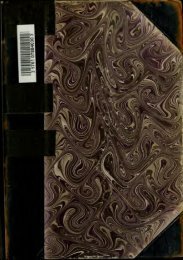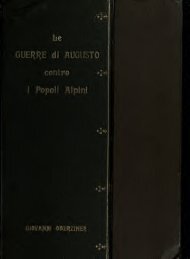Figurative uses of animal names in Latin and their ... - mura di tutti
Figurative uses of animal names in Latin and their ... - mura di tutti
Figurative uses of animal names in Latin and their ... - mura di tutti
You also want an ePaper? Increase the reach of your titles
YUMPU automatically turns print PDFs into web optimized ePapers that Google loves.
i8<br />
Propertius had long before expressed himself <strong>in</strong> almost<br />
the same ve<strong>in</strong> as Pausanias:<br />
Nam quis equo pulsas abiegno nosceret arces, . . .<br />
We may conclude then that the story <strong>of</strong> a military horse<br />
owes its existence only to the long association <strong>of</strong> the breach<br />
<strong>in</strong> the walls <strong>and</strong> the admission <strong>of</strong> the steed, as if the latter<br />
had forced an entrance.<br />
Pr<strong>of</strong>essor Murray suggests that " the stratagem <strong>of</strong><br />
the Wooden Horse may represent only a brilliant afterthought<br />
<strong>of</strong> what ought to have been done," or, if real, " may<br />
refer to a siege tower <strong>of</strong> the Assyrian type."**<br />
Consideration <strong>of</strong> Pl<strong>in</strong>y's statement may be <strong>di</strong>smissed with<br />
the criticism <strong>in</strong> Daremberg et Saglio : On ne trouve, ni dans<br />
Homere, ni autre part, rien qui justifie cette etrange <strong>in</strong>ter-<br />
pretation de la legende.*®<br />
CAPREOLI, Wild Goats ;<br />
®^<br />
transj., The Gable Beams <strong>of</strong><br />
THE TesTUDO <strong>and</strong> MuSCULUS, ALSO THE BRACES<br />
IN THE Catapult <strong>and</strong> Scorpion.<br />
Caesar speaks <strong>of</strong> the beams <strong>of</strong> the musculus jo<strong>in</strong>ed by the<br />
gently slop<strong>in</strong>g capreoli: Has (trabes) <strong>in</strong>ter se capreolis<br />
molli fastigio coniungunt.*®<br />
An <strong>in</strong>stance <strong>of</strong> the use <strong>of</strong> the term <strong>in</strong> connection with<br />
the testudo is found <strong>in</strong> Vitruvius : Supra trabes (testud<strong>in</strong>is)<br />
conlocentur capreoli card<strong>in</strong>ibus alius <strong>in</strong> alium conclusi.*^<br />
Columella mentions the capreoli as a two-pronged<br />
weed<strong>in</strong>g <strong>in</strong>strument: capreolis, quod genus bicornis ferra-<br />
menti est, terra commoveatur.** Although <strong>in</strong> this case the<br />
figure is that <strong>of</strong> <strong>in</strong>verted horns, it seems clear that the<br />
metaphor <strong>in</strong> the structural capreoli is not from the horns<br />
<strong>of</strong> a s<strong>in</strong>gle goat, but from the <strong>in</strong>terlocked horns <strong>of</strong> two<br />
" Prop, iii, I, 25.<br />
"G. Murray, The Rise <strong>of</strong> the Greek Epic, p. 35.<br />
'"Daremberg et Saglio, s. v. aries. The writer <strong>of</strong> the article on oppugnatio<br />
prefers Pausanias's rationalistic view.<br />
"Caes. Civ. ii, 10, 3.<br />
"Vitr. X, 14, 2. In x, 10, 4, Vitruvius speaks <strong>of</strong> the capreoli <strong>in</strong> the<br />
catapult.<br />
" Colum. xi, 3, 46.



![Das Kriegswesen der Alten [microform] - mura di tutti](https://img.yumpu.com/21606999/1/167x260/das-kriegswesen-der-alten-microform-mura-di-tutti.jpg?quality=85)








